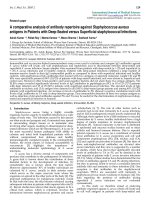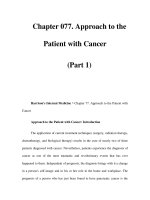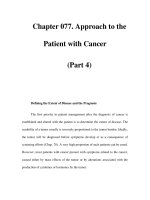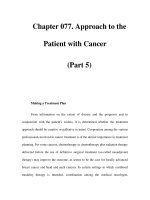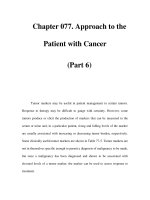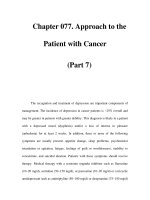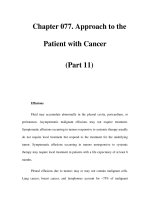Chapter 082. Infections in Patients with Cancer (Part 5) ppsx
Bạn đang xem bản rút gọn của tài liệu. Xem và tải ngay bản đầy đủ của tài liệu tại đây (17.59 KB, 6 trang )
Chapter 082. Infections in
Patients with Cancer
(Part 5)
Sweet's syndrome, or febrile neutrophilic dermatosis, was originally
described in women with elevated white blood cell (WBC) counts. The disease is
characterized by the presence of leukocytes in the lower dermis, with edema of the
papillary body. Ironically, this disease now is usually seen in neutropenic patients
with cancer, most often in association with acute leukemia but also in association
with a variety of other malignancies. Sweet's syndrome usually presents as red or
bluish-red papules or nodules that may coalesce and form sharply bordered
plaques. The edema may suggest vesicles, but on palpation the lesions are solid,
and vesicles probably never arise in this disease. The lesions are most common on
the face, neck, and arms. On the legs, they may be confused with erythema
nodosum. The development of lesions is often accompanied by high fevers and an
elevated erythrocyte sedimentation rate. Both the lesions and the temperature
elevation respond dramatically to glucocorticoid administration. Treatment begins
with high doses of glucocorticoids (60 mg/d of prednisone) followed by tapered
doses over the next 2–3 weeks.
Data indicate that erythema multiforme with mucous membrane
involvement is often associated with herpes simplex virus (HSV) infection and is
distinct from Stevens-Johnson syndrome, which is associated with drugs and tends
to have a more widespread distribution. Since cancer patients are both
immunosuppressed (and therefore susceptible to herpes infections) and heavily
treated with drugs (and therefore subject to Stevens-Johnson syndrome), both of
these conditions are common in this population.
Cytokines, which are used as adjuvants or primary treatments for cancer,
can themselves cause characteristic rashes, further complicating the differential
diagnosis. This phenomenon is a particular problem in bone marrow transplant
recipients (Chap. 126), who, in addition to having the usual chemotherapy-,
antibiotic-, and cytokine-induced rashes, are plagued by graft-versus-host disease.
Catheter-Related Infections
Because IV catheters are commonly used in cancer chemotherapy and are
prone to infection (Chap. 125), they pose a major problem in the care of patients
with cancer. Some catheter-associated infections can be treated with antibiotics,
while in others the catheter must be removed (Table 82-5). If the patient has a
"tunneled" catheter (which consists of an entrance site, a subcutaneous tunnel, and
an exit site), a red streak over the subcutaneous part of the line (the tunnel) is
grounds for immediate removal of the catheter. Failure to remove catheters under
these circumstances may result in extensive cellulitis and tissue necrosis.
Table 82-5 Approach to Catheter Infections in Immunocompromi
sed
Patients
Clinical
Presentation
Catheter
Removal
Antibiotics Comments
Evidence of Infection, Negative Blood Cultures
Exit-site
erythema
Not necessary
if infection responds
to treatment
Usually begin
treatment for gram-
positive cocci.
Coagulase-
negative
staphylococci are
most common.
Tunnel-
site erythema
Required Treat for gram-
positive cocci pending
Failure to
remove the
culture results.
catheter may lead
to complications.
Blood Culture–Positive Infections
Coagulase
-negative
staphylococci
Line
removal
optimal but may be
unnecessary if
patient is clinically
stable and responds
to antibiotics
Usually start
with vancomycin.
(Linezolid,
quinupristin/dalfopristi
n, and daptomycin are
all appropriate.)
If there are
no
contraindications
to line removal
,
this course of
action is optimal.
If the line is
removed,
antibiotics may
not be necessary.
Other
gram-positive
cocci (e.g.,
Staphylococcus
aureus,
Recommende
d
Treat with
antibiotics
to which the
organism is sensitive,
with duration based on
the clinical setting.
The
incidence of
metastatic
infections
following
S.
Enterococcus);
gram-positive
rods (Bacillus
,
Corynebacterium
spp.)
aureus
infection
and the difficulty
of treating
enterococcal
infection make
line removal the
recommended
course of action.
In addition, gram-
positive rods do
not respond
readily to
antibiotics alone.
Gram-
negative bacteria
Recommende
d
Use an agent to
which the organism is
shown to be sensitive.
Organisms
like
Stenotrophomonas
, Pseudomonas
,
and
Burkholderia
are notoriously
hard to treat.
Fungi Recommende
d
— Fungal
infections of
catheters are
extremely difficult
to treat.
